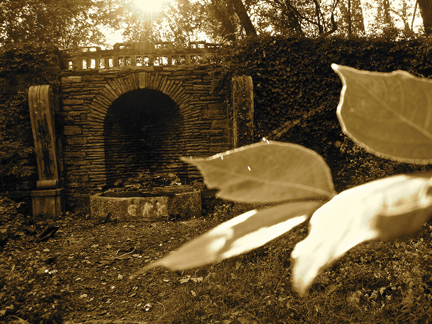The Marauder's Map: Tales from Beyond the Henge

Dauntless explorers Padfoot and Prongs (aka seniors Steven Dean and William Treece ) have forged a path through the Crum on a journey of discovery, sharing their revelations in weekly Daily Gazette episodes. Travel with them, along ancient trails, poke around among mysterious ruins—and maybe even linger on Memory Lane.
Down from the dome
These marauders now roam,
And the course they chart
Leads deep to the heart
Of the mysterious wood,
Where brave Swatties have stood.
Just as the Forbidden Forest of Hogwarts emanates an aura of enchantment and foreboding, so the Crum Woods of Swarthmore has long captured the imaginations of Swatties. Countless students have spent their days contemplating its little-known innards, and a few of us have trekked through those sylvan depths in search of virtue, wisdom, and the occasional place to make out.
Our adventures began outside Mary Lyon (ML), where on a brisk Saturday morning we looked out over the ruins of the five-building ML estate. In 1946, the College bought five buildings from the Mary Lyon boarding school for girls, but the only one that survives as a student dormitory is Mary Lyon 4 (its name on many official College documents), which was known at the time as the Mary Leavitt (hence the name on the stone post outside the dorm). After a hearty breakfast in ML 4, we explored the ruins of ML 2 and ML 3. ML 2, which once held a library, pool, and auditorium, was burnt down in 1982 by arsonists; ML 3 was demolished by the College shortly thereafter. More about the exciting history of the ML buildings can be found on David Bing’s [’03] website.
A squat box of deteriorating concrete—a former servant’s quarters—sits behind the Mary Lyon building. Walking away from the campus, we stumbled upon about five large sections of crumbling stone wall that face a steep incline down to Yale Avenue. These are the remnants of ML 2 (Miller Crist) and ML 3 (The Seven Gables). We meandered through them until we arrived at ML 1 (Wildcliff), which currently serves as faculty housing.
After backtracking toward Mary Lyon, we ventured down Yale avenue toward Crum Creek. As we approached the rear limits of the Strath Haven apartment complex grounds, our ears perked up at the sound of rushing water. Intrigued, we cut inward toward the creek and were greeted by the sight of a majestic waterfall. There, ensconced in the long shadows of Strath Haven, the Crum Creek makes a private display of its humble power to all who are curious enough to venture near.
As we sat serenely in the presence of the waterfall, the spirit of the Crum called out to us. It led us over the river and through the woods into its epicenter at the mythical Crumhenge. Forged from the rubble of the Hall Gymnasium when it was demolished in the 1980s to make way for LPAC, Crumhenge began its life as 20 pieces of crumbled Wissahickon Schist arranged in a circular pattern in Crum Meadow.
Towering over Crumhenge is the skeletal bridge that the SEPTA trains run across en route to Elwyn. The creek runs beneath it, and a small waterfall provides a shallow ford to cross over to the other side. Once there, you might come across fancily named Redwall-esque niches like Hogback Knoll or Oxbow Swamp. You’ll probably encounter the remnants of long-forgotten science experiments, adorable invasive species, and perhaps some unculled deer.
We can confirm that legendary ruins in the Crum do, in fact, exist. According to a 2003 report by the Crum Woods Stewardship Committee, they are known as Hinkson’s Water Garden. The water garden is all that remains of what was once a very large suburban estate; the construction of the Blue Route wiped out most of it, but a small gated fountain still stands, shrouded in overgrown foliage and surrounded by crumbling stone.
A 1986 Phoenix article about the ruins says that, at the time, the preferred method of Crum-wandering was to walk along the train tracks until you arrived at your destination. If a train came your way, you just hopped to the other set of tracks. Interestingly, that article coincided with the 1986 movie Stand By Me, in which four adventurous boys spend days walking along some railroad tracks—and nearly meet grisly fates as a result. This method of Crum exploration is, quite frankly, foolish; not only is it exceedingly dangerous, but it takes away from the thrill of deep-woods exploration. If you’re going to explore the Crum, be safe—take a buddy, and inform some friends of where you’re going.
On our way back out of the woods, we passed beneath one of its most well-known sites, known colloquially as Alligator Rock. Nestled behind the Science Center, this sheer rock outcropping is a common gathering place for Swatties interested in philosophical banter or simply relaxing high up among the treetops, with the distant sounds of the creek drifting lazily up the slope.
Back in the day, the Crum held a reputation as a place to pan for garnets—some suspect a connection between the precious stones and our school colors. The woods continue to inspire Swarthmore’s culture: Our Crum now serves as a cross-country route, ecology lab, occasional theater, and general campus treasure. And if nothing else, we can take solace in the knowledge that our Crumtacular forest is neither forbidden nor rife with centaur warriors—just some friendly squirrels and maybe a few deer.
 Email This Page
Email This Page